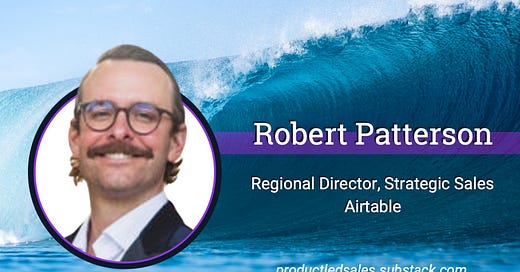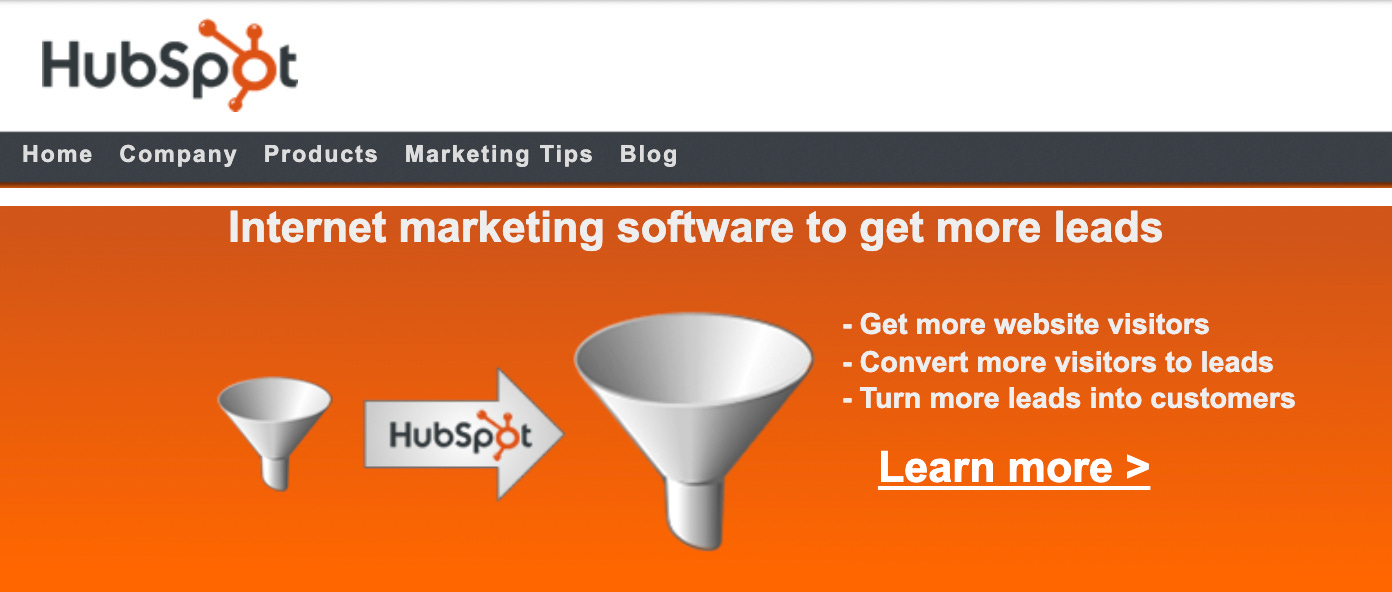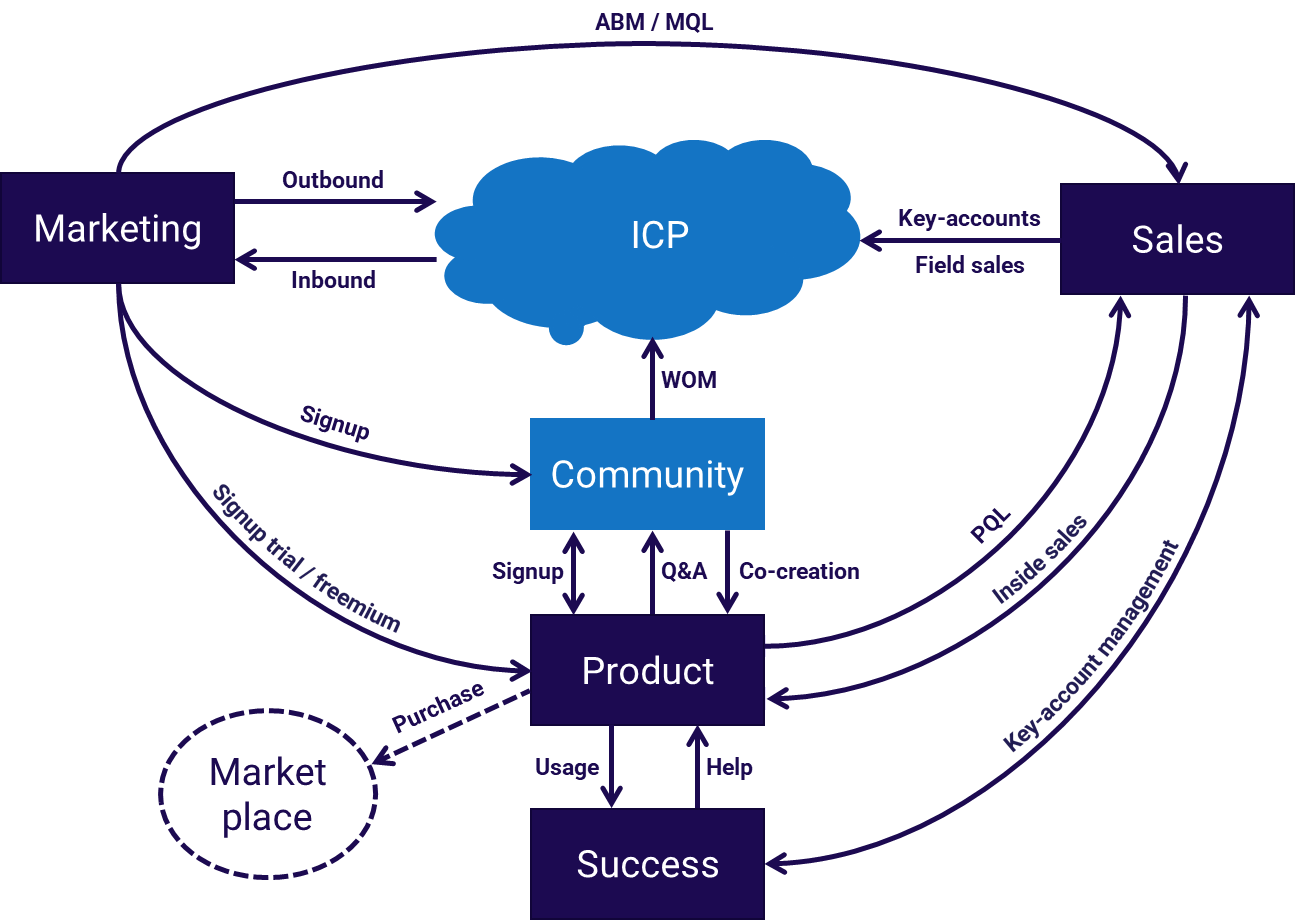PQLs + PQAs, Elegantly Going Around End-Users to the Decision-maker, & the Blending of a Bottom-up and Top-down Motion | By Ryan Patterson, Strategic Accounts at Airtable
Product-Led Sales 🌊
Welcome to all the new Product-Led Sales 🌊 members who have joined us since our first post! Join the smart, curious folks by subscribing here:
Hey y’all!
We launched the Product-Led Sales newsletter with the goal of showcasing the best salespeople and sales leaders at PLS companies. Each interviewee “passes the baton” to another person at a PLS company who they respect. So, this newsletter is “by the people, for the people.” Expect these to start coming more consistently going forward. 😎
Our first featured product-led sales expert was Katie Jane Bailey, Senior Account Executive at Figma. If you missed it, check it out here: Mobilizing your Champions, Maturing with your PLG Motion, & Being Okay with Friction.
KJ passed the baton to Ryan Patterson, Regional Director, Strategic Sales at Airtable.
Ryan has been in SaaS since 2007.
To put that in perspective: in 2007, HubSpot was an itty bitty baby company with a homepage that looked like this.
With a SaaS career that spans venture funding, content and sales, Ryan was most recently part of sales leadership at Mixpanel for five years, and has been with Airtable almost two years now.
(Side note: for the two of you reading this who don’t know what Airtable is yet, it’s a low-code platform for building collaborative apps. A win/win for product-led growth.)
Today, Ryan shares his 15 years of experience with us, digging into:
Blending of a bottom-up and top-down motion at Airtable
Elegantly going around end-users to the “decision-maker”
Adjusting your pitch based on the role
PQLs and PQAs at Airtable
The human touch in Enterprise PLG companies
Targeted top-down sales as Airtable expands as a “platform”
Enabling champions with “the three whys”
Telling our story through “champion decks”
Now, I’ll pass the mic off to Ryan…
Blending of a bottom-up and top-down motion at Airtable
PLG is super exciting because the product is the marketing.
It’s brand recognition and value delivery, before a salesperson ever gets an individual prospect on a call.
But it’s not the only motion for a SaaS company. At Airtable, we rely on PLG quite a bit for growth. However, we also have a traditional, top-down enterprise sales motion. (We lean on a sales process created by Force Management, using MEDDIC for deal qualification.) Our sales team has a relentless focus on pipeline generation.
Why?
Because the challenge with product-led growth is making it to the decision-maker. Because people can use your product without needing to get budget, often your decision-makers for the initial land are maybe a manager or a senior manager who have access to some level of budget, but probably haven’t navigated larger software purchases on their own.
(Side note: I believe that a large part of sales is navigating a big bureaucracy, where enterprise companies have been trained to not frivolously spend money on software and do everything they can to eliminate tools. It’s hard to buy software at scale within an organization, and that’s just as frustrating for the sellers as it is for the buyers.)
To help address this challenge, we devote Mondays to pipeline generation, and have the AE own all of that. We target, test, and confirm champions — typically at the director or the senior director level. Step one: understand who the executive buyer is. Step two: work on signing a larger, team-wide or organization-wide use case with that executive buyer, who will be the most likely to become your champion.
At Airtable, it's really exciting because we get a lot of bottom-up, organic growth. But, as a business, we’re investing in the very high ceiling workflows (i.e. 500 to 1000s of users) versus being a collaborative “Slack-type” offering.
We're really trying to do both PLG and top-down sales. To do both, you need to be able to build champions.
The problem is when you go into most accounts that have grown on their own, you're at a much lower seniority level. People who are using the product already have no incentive to introduce you to their boss. That’s one of the challenges we’ve started to face when selling into an enterprise that has already started adopting Airtable.
But it’s not insurmountable.
(Elegantly) going around end-users to the decision-maker
When we do need to get to a current user’s boss (the “decision-marker”), we aim to make it as elegant and respectful as possible. Our end-users, after all, are important to Airtable. They’re the ones creating things and taking on risk to solve operational challenges.
Regardless of seniority levels, these are the early adopters that are driving the growth for our business.
We view it as mission-critical to have really good relationships with our users who come from direct product signups—we want to always be delivering value to them.
With that in mind, the transition becomes about the AE either identifying whether or not the user is a potential champion—is this someone who has influence within their organization and has a desire to go out and change things within the organization beyond the workflow that they've already built within Airtable?
If so, that person may be your champion.
Then it's about painting a picture. It’s something like:
“Hey, you've done really great work with this specific team. But imagine if you were able to roll this out to all of Marketing.”
or
“Imagine two years from now: Marketing is using it, Product is using it, Engineering is using it, Sales Operations is using it.”
Then you see what resonates with them. Some people may be indifferent (“I have a day job. It’s just enjoyable to use.”) You don't want to push those types of folks really hard—but you do still need to get to the boss eventually.
I coach my team on wearing their “salesperson hat.”
In this context, it’s about explaining to the user: “Hey, look, my job is to grow the relationship. That's why I'm here. That's why I'm managing the relationship. Inevitably, I do need to go and connect with executives within the business."
Then, when you do go to their boss, champion them. (“Steve is doing amazing things for your organization—he’s tackled some pretty important challenges. I imagine you have some bigger challenges you’re trying to handle, too. Do these resonate?”)
It’s about figuring out who is a potential champion—not trying to force them into being one. If you have a champion in an end-user, you’re set. If you don’t, it’s about articulating why you’re going to their boss.
Whether you’re approaching the end-user or the decision-maker, you need to understand who you’re talking to. For individual contributors, ask how you can help them in the day-to-day and help them understand the wider challenges. For decision-makers, make it clear how the end-user is already benefiting and ask them about wider challenges within the organization.
That’s the motion. Sometimes there's friction—but it’s important to continue to move up the chain so you don’t hit a level where the software won't continue to grow itself within an account.
How do we identify a champion in the first place?
Let’s take a step back for a minute.
For us, a champion is someone who sells on your behalf, has a personal win, someone who has influence within the organization, and someone who can repeat what we call “the three whys”:
Why do anything? (Why buy any software)
Why do it now? (Typically pain-related)
Why would it be Airtable?
The champion needs to be able to go and sell on your behalf and repeat those whys on their own, in their own words, and with their own motivations.
We enable champions with what we internally call “champion” or “sell decks” – essentially, it’s a business case.
These include a template that all the reps are enabled with, that will recap corporate strategy initiatives and how those ladder down to the challenges. And they include the “the three whys”: a.) the pain that we're in, ideally getting to dollars, b.) the overall positive business outcomes we want to drive, and then c.) required capabilities to actually get there.
We’re getting champions to answer a big-picture but non-rhetorical question:
"What would this utopian software need to have, to get me out of pain and get me to that beautiful future where we're driving a lot of revenue or reducing costs?"
These champion decks aren’t Airtable branded, or even all that focused on Airtable value props and features. Instead, they take this approach:
"You said that you're in this pain and that you want to solve this problem. We agreed that these are the required capabilities that you need. This is how Airtable does it."
The champion decks mold the story into the champion's own language and then present it as clearly as possible. We have decks floating around that look like a customer deck – you wouldn't know the difference if you were on their side.
That’s intended to enable our champions to tell the story really effectively internally without having to put a bunch of work into it.
PQLs and PQAs at Airtable
To help drive these conversations forward, we have a concept of Product Qualified Leads and Product Qualified Accounts.
Here is how we support a buying journey at Airtable.
On the new business side, we have two different motions for accounts:
PQAs - reaching out to someone when they hit a specific threshold of usage within the account.
Greenfield - this one is new, but is more traditional pipe gen in accounts with little to no Airtable usage or awareness.
Then, we have an onboarding specialist team. Their real focus is on delivering value to the first creator within the account. For instance, when the first person at Apple signs up for an account, someone from this team will reach and basically consult and deliver a little bit of value.
As the usage begins to get a bit more viral, it becomes a Product Qualified Account, and it goes into a new business territory, who's then calling into that existing usage and trying to ladder up to the functional executives that would care or identify even bigger challenges.
Finally, we get to my team that I’m a part of, which is an expansion team, meaning, as we close customers, I’m one of the teams that will inherit them.
We also have a concept of Product Qualified Leads. We use data science to surface people that are showing intent within the product.
These are free users showing growth activity, but not necessarily attached to a main contract. Indicators include things like adding 3 custom apps to their workspace or inviting 10 users within 30 days. Metrics like that will then be automatically surfaced through Salesforce to either an SDR or AE, depending on the team.
With these automations, there's a treasure trove of data that we love to leverage to identify when we should speak to someone in their journey.
Targeted top-down sales as Airtable expands as a “platform”
Airtable is evolving as a business.
In the early days, we were an app platform for small teams or individuals to be able to work more effectively. That's still a problem at scale for organizations, where they want to empower their employees to be more effective at their work and not burn out—especially in hybrid environments.
Our core value proposition at Airtable is the same. But we’re trying to get this message across within very large customers.
Those are typically much more complex enterprise workflows, where you need an executive to be able to point out the challenges. Otherwise, teams grow in little pockets—a team of 10 over here, a team of 15 over here. This creates challenges down the road because there's no governance around how they're using the product.
Then, when it comes to syncing all that data and starting to build data sets across functions, they’re named differently and they don't interact correctly. This is why it's important to actually sell top-down into a company. Otherwise, you may end up in a situation where 500 of a 1,000 person department are using Airtable, and you'd have to revamp the entire thing to get the whole team onboarded properly. You’re left doing change management on the software itself.
In summary, we're very much doing a hybrid of both bottom-up and top-down at this point.
PLG gets the account to be warmer. We land it. PLG helps it spread a little bit wider in the account. And from there, my team is doing a much more traditional top-down enterprise sale: mapping the organization, enabling champions with business cases, and so on.
This combination keeps the ‘human touch’ in enterprise PLG, too. At Airtable, we have rolled out Force Management and have a commitment to having a best-of-breed product and a sales excellence machine.
Because, at the end of the day, there's only so far that PLG will take selling a product into the enterprise. The human, value-based touch is absolutely necessary.
So what that does mean?
On my team, we are also calling into groups that don't have any usage whatsoever. If there are users in Marketing, we may call into Product or other teams. Then it becomes a very similar sale to, for example, Salesforce or other more traditional top-down enterprise sales.
Closing thoughts: Always be leaving
More than anything, adding sales excellence on top of PLG is all about remaining customer-centric.
PLG and sales work together beautifully on this front.
It's about moving away from the old school sales world of, "Let me do a demo. Stop me when you see something you like."
Instead, it’s moving more into, "These are your words, this is the pain you described, and these are the capabilities you’re looking for. Interestingly, it seems like Airtable solves a lot of those pains."
We’re not trying to push things onto customers that they don’t want. A big part of our culture is around a phrase you don’t often hear in sales: “always be leaving.” Meaning: just be ready to leave it. Don't make the customer feel uncomfortable or that they can't tell you "no."
It's about exploring whether we can help, not convincing them that we can help.
That's an important distinction.
The last six months of combining the sales excellence machine with the PLG motion has been so fun. It will be fascinating to see what that does for the business over the next few years.
Exciting times ahead for us!
(P.S. We’re hiring across the board, so come find me on LinkedIn.)
ICYMI—Other Product-Led Sales Goodies:
Kay Iversen posted the Modern GTM playbook for B2B SaaS. Here is the TLDR:
Everyone seems to have a take on the “PLG CRM” space (including the name 🙄). Sapphire Ventures just published a great article on the space that gives a helpful overview and how it may evolve over time (it’s still so early!) → Product-Led Growth (PLG) CRMs Emerge: Mapping the Market and our 2022 Predictions.
Harry Stebbings put out a great interview on his podcast, “The 20-Minute VC” with Dannie Herzberg, Partner at Sequoia Capital → 20 Sales: How To Build Sales Teams with a Product-Led-Growth GTM. They also talk about how to define your “sales hiring scorecard” and how to structure the onboarding process for all new sales hires.
Salesforce boasts $1B+ in Q4 for their “data” business—namely, Tableau and Mulsesoft (h/t Nick)
Hamid Palo laid down some truth about PLG recently. Here’s how he opens: “Every time I log onto LinkedIn I see an eyebrow raising post about PLG, so I'm going to rant a bit. This is based on what I learned at Atlassian and Trello.” Peep the full LinkedIn post here, it’s juicy.
Last, but not least, one of the godfathers of SaaS shares some of the lessons he’s learning around public PLG companies:
Go follow Ryan on LinkedIn. And if you enjoyed this post, please forward it along to a few folks and post it on social media (tag me, Brendan)—I appreciate your support! 💜
Thanks for reading and we’ll see you next time!
-Brendan






